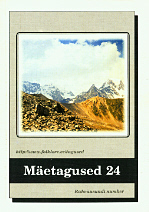Mesilane slaavi kultuuri sümbolkeeles
Bee as a Symbol in Slavonic Culture
Author(s): Alexandar GuraSubject(s): Customs / Folklore
Published by: Eesti Kirjandusmuuseum
Summary/Abstract: Folk tradition explains each animal through an invariable and complete group of characteristic features, which correlates with a group of characteristic features inherent of a given character in specific local traditions. The cultural language of each tradition prefers some qualities, attributes, predicates, etc. of the animal to others, and attaches symbolic significance to these, while excluding others from the cultural frame and context. In this case one and the same animal can inspire widely different, often unassociated symbolic meanings. The article observes the mechanisms of symbolisation inherent to cultural language through a creature well known in popular zoology - the bee. Bee is thought to be superior of other insects because of its divine heavenly nature. Of all other insects only ladybird beetle and silkworm have been attributed similar superiority. In etiological legends bees, as the creation of God, are opposed to bumblebees, hornets, wasps or flies created by the Devil. The Slavonic people honour bee as a pure creature of God. The texts and apicultural traditions of the Slavonic people associate the bee also with the Mother of God. Folk tradition attributes the bees purity and sacredness, but also virginity and celibacy. Their chthonic qualities become evident in a motif of their originating from a cave of a mythical rock, etc. The superiority of Christian thinking over paganism in these beliefs can be explained by the special role of apiculture in folk tradition in general. This autonomous and esoteric sphere of culture, practised only by men or professional apiculturists, became the preserver of the archaic layer of ancient traditions and beliefs, but was also susceptible to the influence of literature (often mediated by beekeepers as an educated class of village community). The spread of literature greatly contributed to the penetration of Christian elements in this sphere of tradition.
Journal: Mäetagused. Hüperajakiri
- Issue Year: 2004
- Issue No: 24
- Page Range: 109-118
- Page Count: 10
- Language: Estonian

